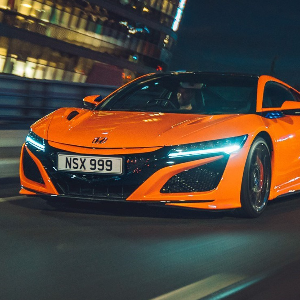
Honda’s first mainstream all-electric offering has plenty of charm, but can it deliver the goods when it matters?
Pros:
+ Characterful design
+ Unique interior
+ Fantastic in-town driving manners
Cons:
– Expensive
– 125 mile range is low
– Tiny boot
Verdict: The Honda E is a very lovable little car that’ll no doubt have a cult following, however, how big that cult will be is up for debate. Around town it is a fantastic EV delivering plucky performance in a compact package, but venture on to faster roads and its unpredictable range lets it down. This is very much a city car, a good one might we add, but at £28,215 rivals for similar money offer a larger battery.
2021 Honda E: five-minute read
Whoever said that electric cars had to be boring? Soulless milk floats that will ultimately kill-off our beloved combustion companions? Ok, so some can be a little dull, but not Honda’s first mainstream electric offering as it sticks very close to its coveted concept car. Morphing from Urban EV concept to the production Honda E, the quirky ‘future retro’ design is plenty characterful with its big round eyes and petit proportions.
In a similar fashion to the Fiat 500 and Mini, Honda designers have managed to create something with real personality. A choice of colours ranging from vivid to subtle, each with contrasting glossy black features help create something as slick to look at as the latest iPhone. Go for the Advance trim and some snazzy black and silver alloy wheels further add to this city car’s style statement.
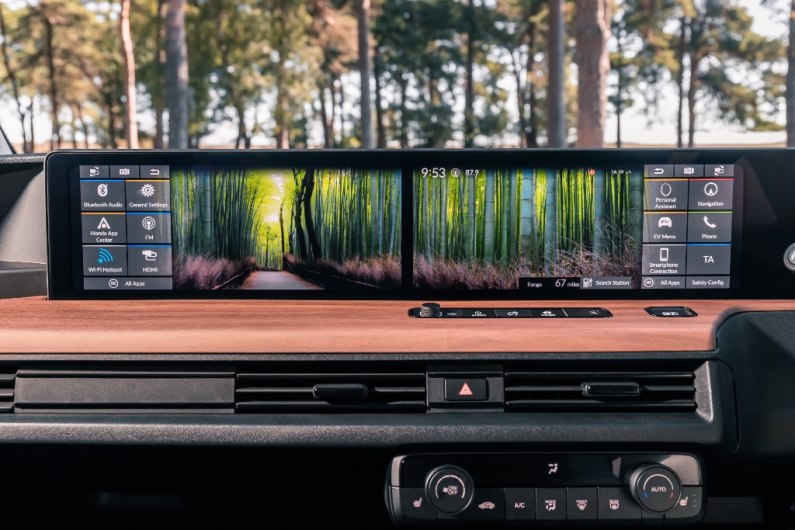
The interior is just as commendable as the exterior. You are greeted by an airy feeling cabin full of light colours and wood trims – a zen-like space. It’s very Japanese in the way technology is put centerstage with a bank of large screens spanning the dashboard like something from a sci-fi film. The outermost displays serve to show the view form a pair of cameras that replace traditional wing mirrors – an adjustment at first, but undoubtably provide better visibility overall than polished glass. A pair of huge 12.3-inch touchscreens serve as infotainment displays, with one being dedicated to the passenger being a genus idea. Sadly, the software could be better and its somewhat clunky nature leads it to be a bit more of a gimmick than a game changer.
The Honda E is more practical than its Urban EV concept that spawned it thanks to a set of rear doors. This being a city car, don’t expect limo-like levels of space, meaning that the rear bench is best suited for children. Adults will squeeze inside, but limited leg room will make longer journeys less comfortable. Something all passengers will relish is an abundance of charging for today’s electronic necessities, a roster that even includes a three-pin plug for something like a laptop or games console if ambitious. Boots space is a bit of a challenge thanks to this car’s electric motor being mounted at the rear. A total of 171-litres is ok for a couple of shopping bags, but a chunk of this is taken up by charging cables that have nowhere else to live.

The Honda E has a claimed range of up to 136 miles on a full charge, something that takes four and a half hours from a 7kW home wallbox. An old-fashioned three-pin socket does the same in 11 hours, but if you can find a 50kW rapid CCS charger, 0-80% can be done in just 30 minutes.
The key difference between the regular car and Advance models is a power bump from 134bhp to 152bhp, both have the same 315Nm of torque, meaning that progress is zippy. Its compact nature allows you to duck and dive through busy areas, and an amazingly tight turning circle highlights how tailored it is to city living. It’s no sports machine with some notable body roll, but it’s a real feel-good car that will put a grin on your face as you silently run rings around conventional cars.
Honda’s little EV falls down when you hit faster roads. In this environment the predicted range plummets at anything over 55mph, leading to the range anxiety we all thought had been left behind. You might think the E’s range will serve you well for an occasional 80 mile dash up the motorway to visit a relative, but in truth on a cold day you’ll need to stop and top up the battery along the way. The car is very capable at speed, never feeling out of its depth, but the battery range really does suffer.
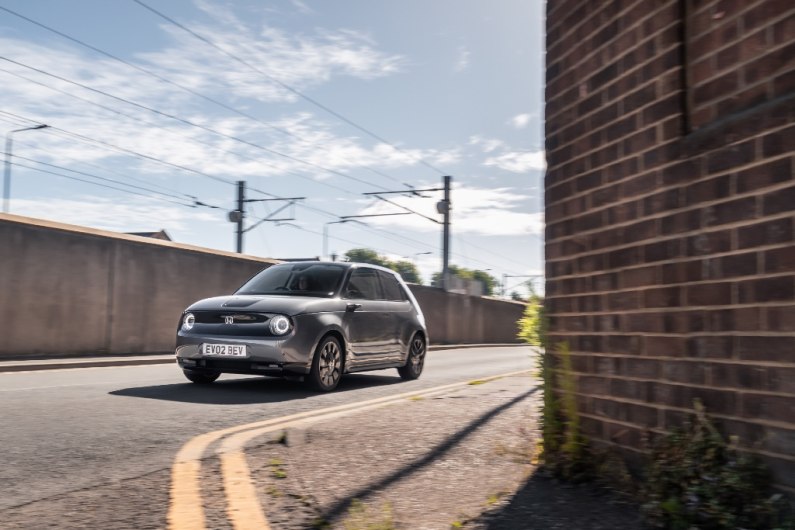
The Honda is an utterly brilliant urban electric car, and will be the perfect match for those who live and work locally. However, journeys further afield are only comfortably achieved with the luxury of home charging or relying on the public network. To be fair to Honda, the E is marketed as a car for urbanites, and it firmly fits the bill, but right now it’s likely going to be a cherished supporting role on your driveway next to a combustion car.
2021 Honda E practicality and boot space
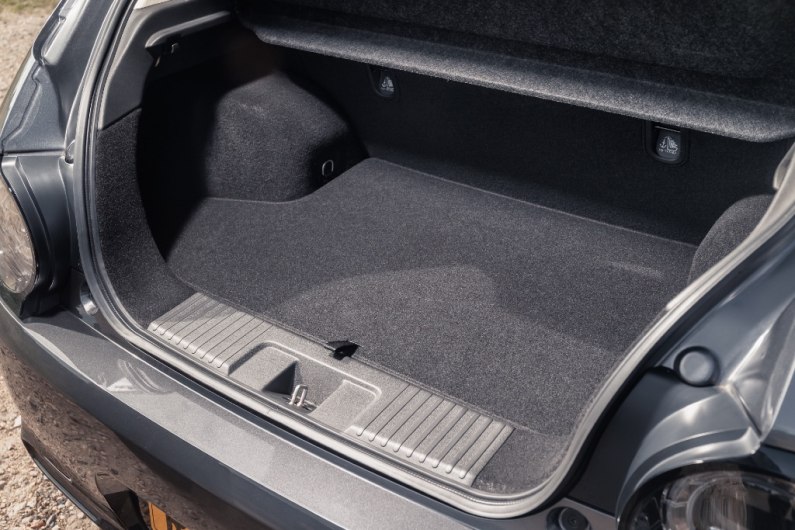
This compact EV does a great job of promoting a sense of space. Large windows and a glass panoramic roof on Advance models flood the cabin with natural light. Go for light tones for the interior and it quickly becomes a cozy lounge-like place to spend time. While minimalist, there are some clever storage compartments for nicknacks, particularly between the front seats, something crowned by a hidden additional cupholder. Unlike its French counterparts, the Honda E does possess a good size glovebox, although door bins are on the skinny side.
Small car means small space – you can’t escape physics. Open the rear doors of the Honda E via a hidden handle that helps create a three-door appearance from the outside, and you’ll find a rear bench to seat two. The seat itself is a spongey fabric affair, more akin to a sofa than anything else. The welcoming materials continue that homely feel, however, this space is best suited to children. Leg room is a little tight for adults, although the car’s boxy nature means head room isn’t that bad.
Boot space is a point of contention as a result of the Honda’s packaging. The E is rear-wheel drive with the electric motor mounted at the rear, meaning that the boot isn’t all that deep. At 171-litres it’s smaller than that of a Fiat 500 and shamed by the Volkswagen e-Up’s 251-litres. It’s fine for a couple of shopping bags, but airport hand luggage would be a squeeze. Things are made worse by the fact that there’s nowhere to store the car’s charging cables, meaning they too have to live in the boot.
While it would have been helpful for the Honda E to have some additional storage under the bonnet, having its charging port on the nose does make for easier access when space is tight.
2021 Honda E motors
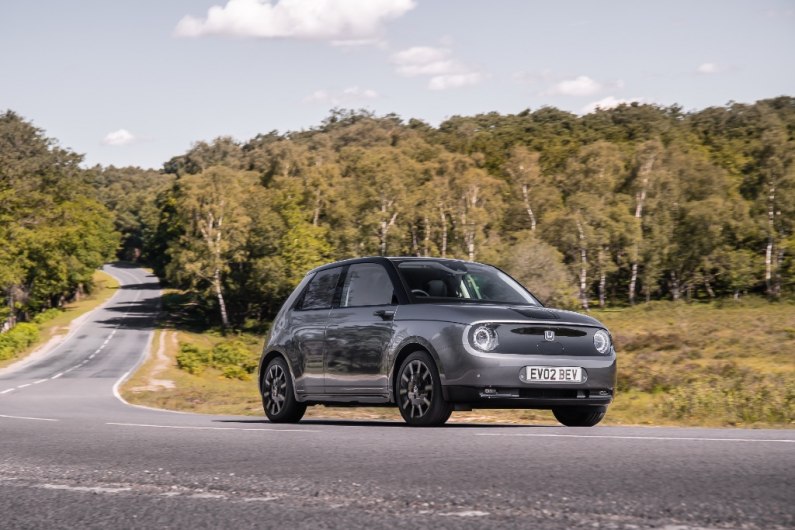
The Honda E comes in two different flavours, Honda E and Honda E Advance. Both share the same 35.5kWh battery, and both can rapid charge 0-80% from a 50kW CCS charger in 30 minutes. In fact, both models have identical torque outputs of 315Nm. So what is it that actually separates this pair?
Ultimately it’s down to power and range. The standard car gets 134bhp, while Advanced examples get 152bhp. This power bump reduces predicted range from 136 miles to 125 miles, but does also reduce the 0-62mph sprint from 9 seconds to 8.3. In reality, with the same torque levels, most people won’t miss the 8bhp or 0.7 seconds of their lives. Equipment is the main allure of Advance cars.
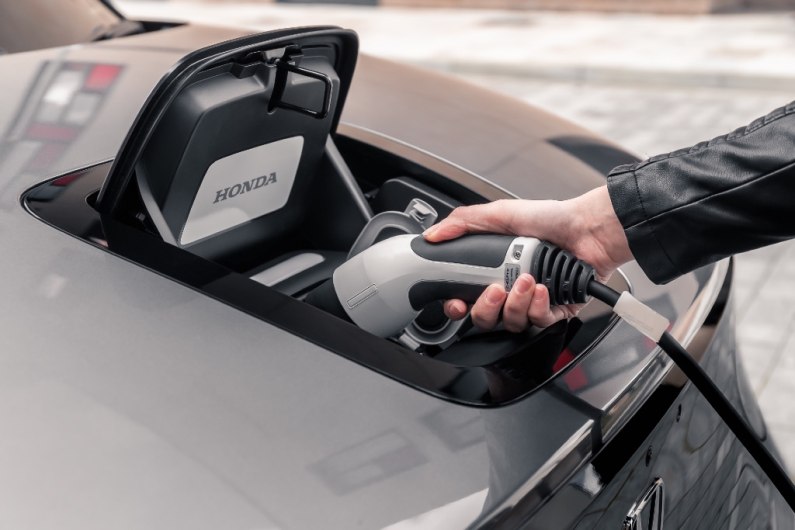
As mentioned a 0-80% charge from a 50kW CCS rapid charger can be done in as little as 30 minutes, meaning that if you don’t have access to a home charger but do have a CCS public unit nearby, the Honda E could be viable. Plug in at home via a 7kW wallbox and you’ll have a full battery in four and a half hours. If you have 11 hours to spare, a three-pin plug will also add juice.
On the road the motor is immediately responsive as we’ve come to expect from most electric cars. The traffic light grand prix from 0-30mph results in the frequent shaming of boy racers, something that rarely gets boring. Quiet and smooth running is the order of the day from EVs, and that’s exactly what you can expect here.
2021 Honda E driving
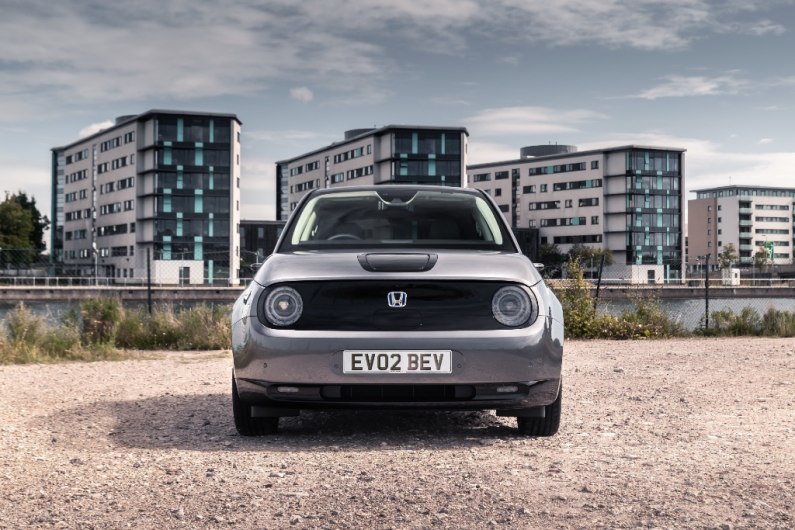
In some respects the Honda E reminds us of the original Mini around town. Yes, yes, we know it’s nowhere near as small, nor are we suggesting it will become an international icon, but the Honda has a certain pep to it. The short wheelbase that boosts agility, zippy electric response and overall pocket sized nature sees it easily dance through congested spots and take advantage of tiny gaps in traffic. Considering that this is a little city car, it has more torque than some noteworthy sports cars.
The steering is light, but not totally devoid of feel, making the E the perfect partner for parallel parking. Good visibility from its large windows is enhanced by the door-mounted camera that replaces regular mirrors. They take a bit of getting used to, but their enhanced viewpoint and ability to adapt to the dark actually makes them a more useful tool than old-fashioned glass mirrors. Advance cars also get Honda’s Park Pilot that sees the E scan for available spaces and practically park itself. The system works well, is intelligent enough to not need vivid lines on the ground, and will surprise you as to the tight spots the car will fit into. A turning circle to rival a London taxi is also very impressive.
There’s a real feel good factor to the Honda E when driving around town. It feels like a cheeky little character and the public respond well to its looks and are often keen to ask questions. It silently goes about its business, with a futuristic whirring noise creeping into the cabin under intense acceleration. It’s a refined thing to potter about in with minor disruption brought about via a slightly oversprung ride at low speeds.
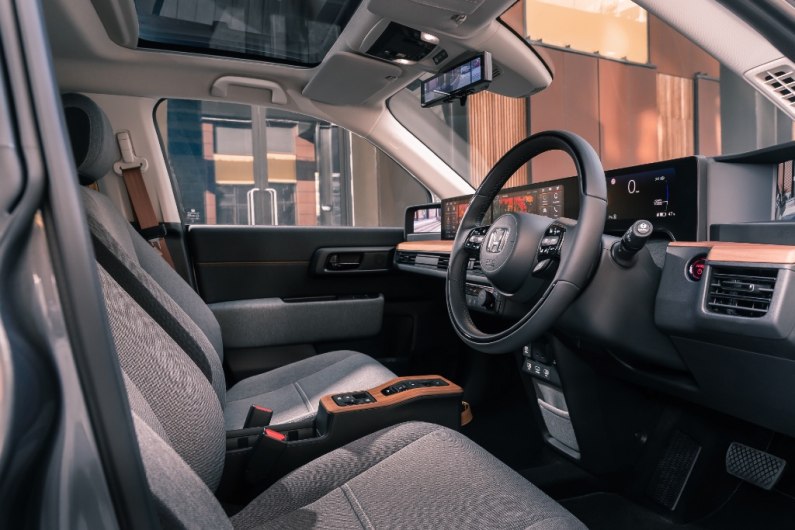
Surprisingly, the Honda E isn’t bad when you pick up the pace on more flowing roads either. Despite its skinny tyres, the little city car is keen to get its nose into a corner, with that short wheel base and rear-wheel drive rotating the car nicely. There’s good levels of grip, although you will inevitably run into understeer if too exuberant. Some body roll through sweeping bends is present, but the car’s low centre of gravity mitigates this somewhat. It’s a competent little package that can make the most of its zero-lag drivetrain.
It also impressive with its ability to keep pace one a motorway. Joining on of Britain's bustling stretches of fast traffic, the Honda simply hitches up its skirt and gets a gallop on. Outpacing a diesel car for in-gear ‘get up and go’, the Honda is very happy to make bold overtakes. It feels composed at speed, too, never giving off a sense of nervousness. There is some wind noise that builds, but that’s primarily because there’s no engine noise to mask it. The problem comes when you look down at your predicted range.
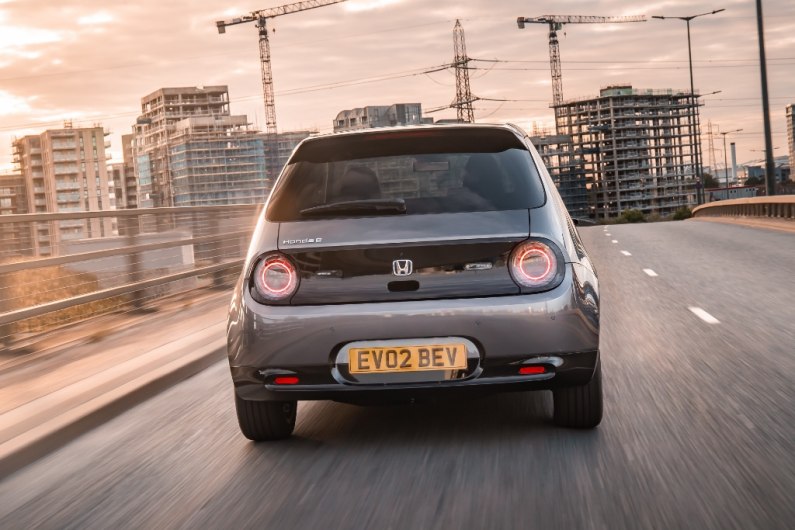
Around town the Honda E steadily draws from its battery in a predictable fashion, however, above 55mph it’s a different story. The battery drains faster than anticipated, and that spells trouble for an EV with an already small range. Yes, Honda do bill this as an urban car and not something to regularly trawl the motorway with, but when you absolutely need to get somewhere for whatever unforeseeable reason, a lack of faith in how far the car is telling it will go isn’t what you need. On a cold day range can shrink to as little as 80 miles, and potentially less at a steady 70mph. All of this isn’t a problem for a vehicle that will only ever live in town or is used as a second car, but with rivals that offer a bit more of a buffer in terms of range, the Honda comes up short when venturing onto the M25.
Despite its shortcomings, we adore the Honda E and properly fell in love with the car while testing it. As a compact EV to drive around the urban sprawl it is one of the best. It’s also fantastic to see the enthusiasm that other people have for it with teenagers asking about plugging in their Xbox to the screens, fashionistas snapping it for Instagram and even the grey haired amongst us pointing it out in car parks. As an ambassador for electric cars, it has to be commended.
